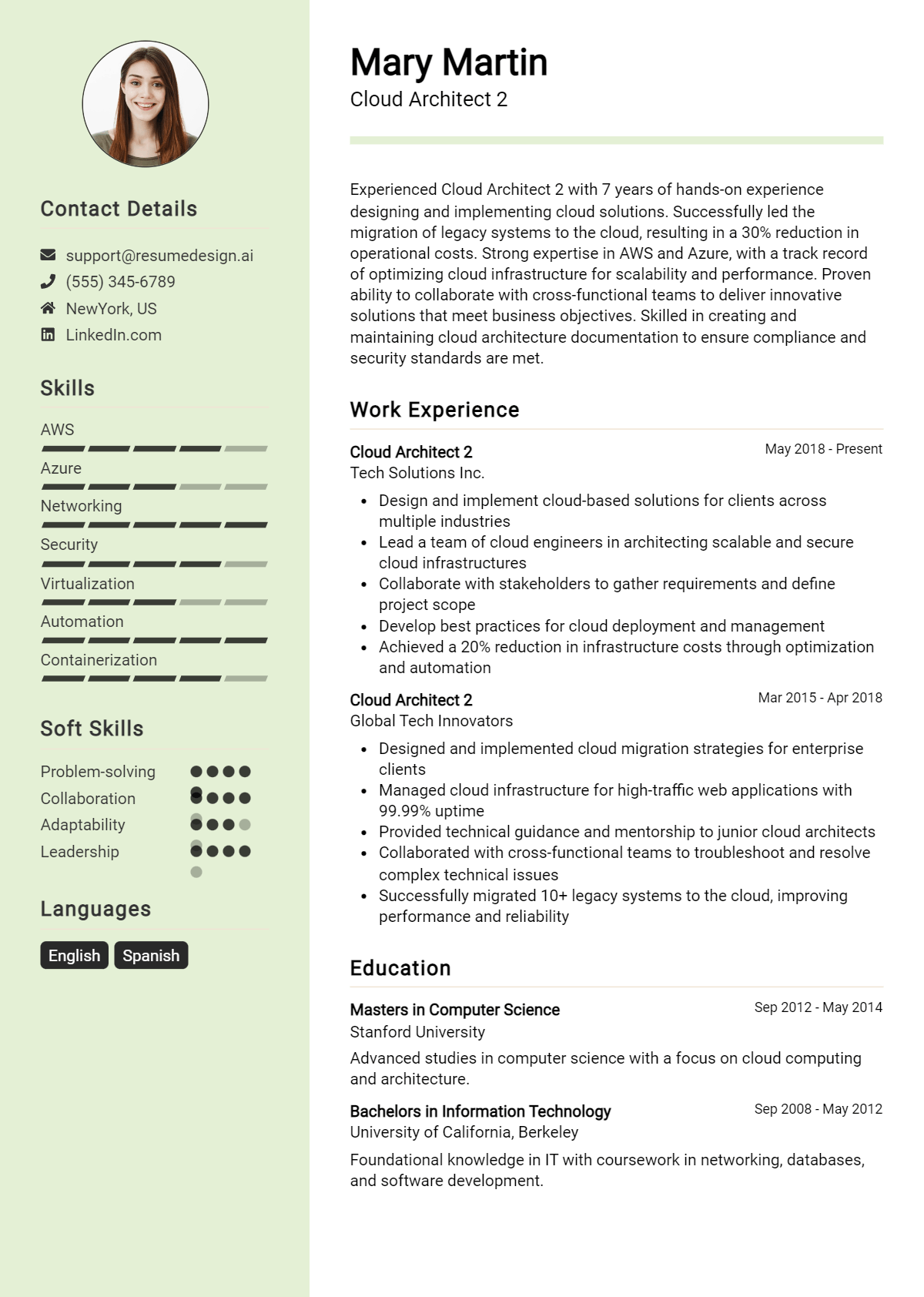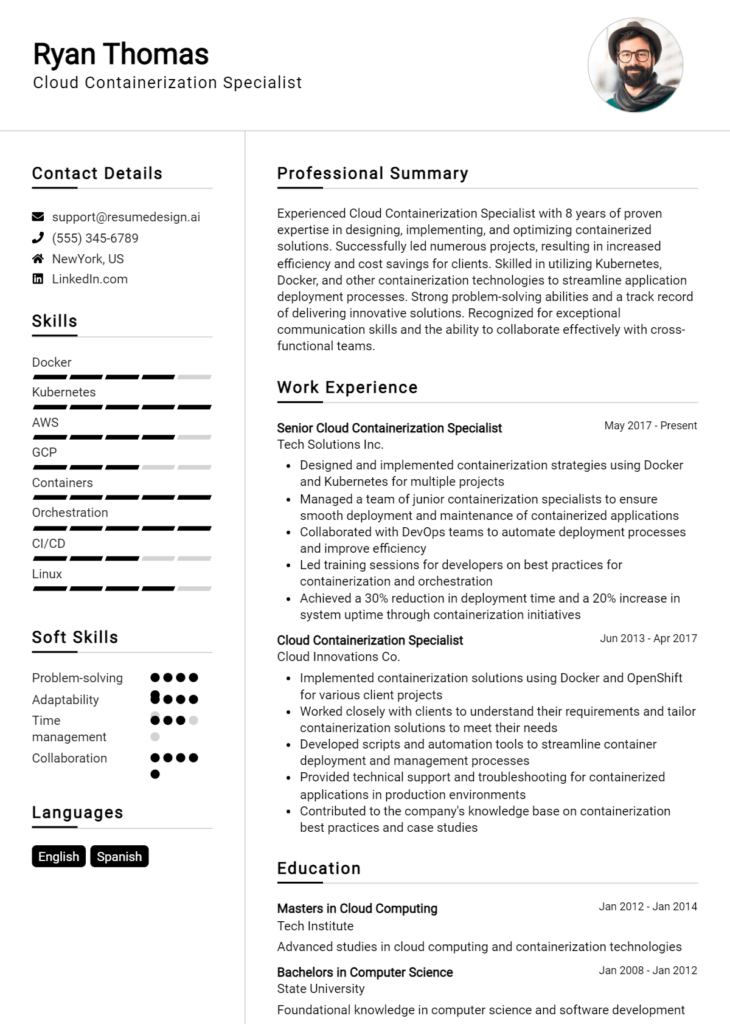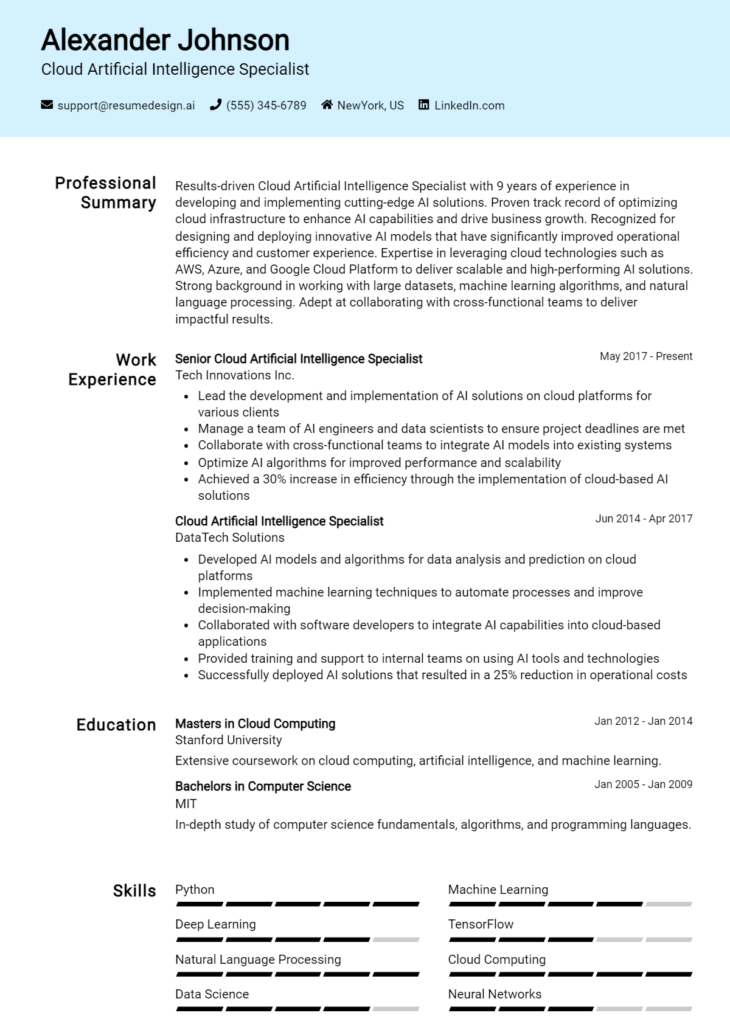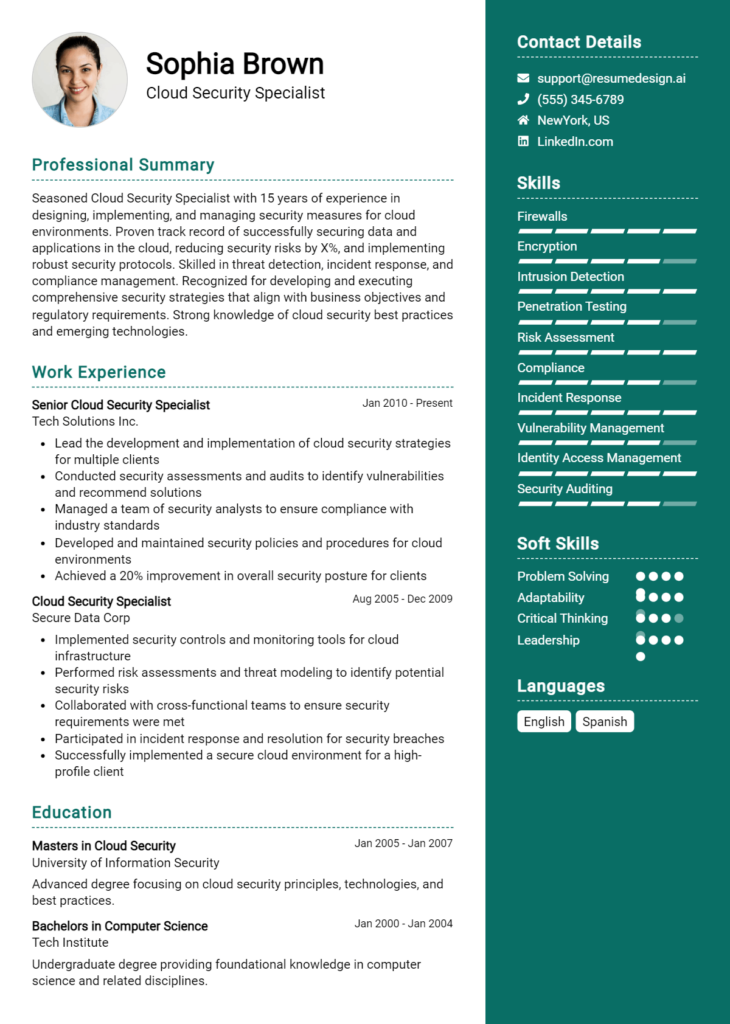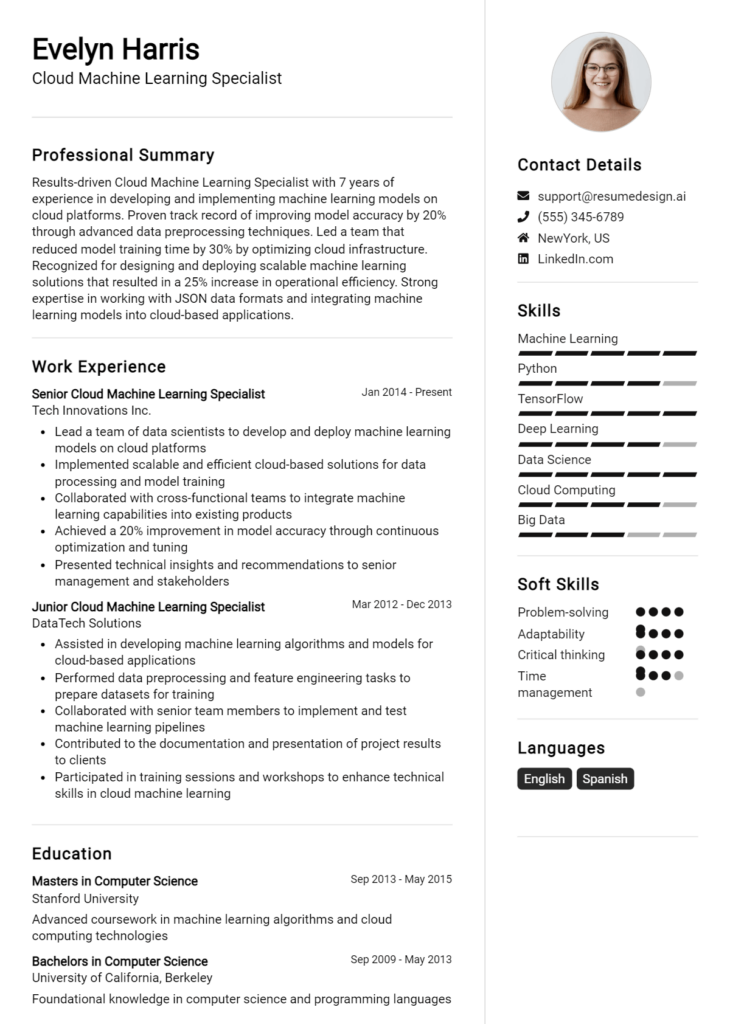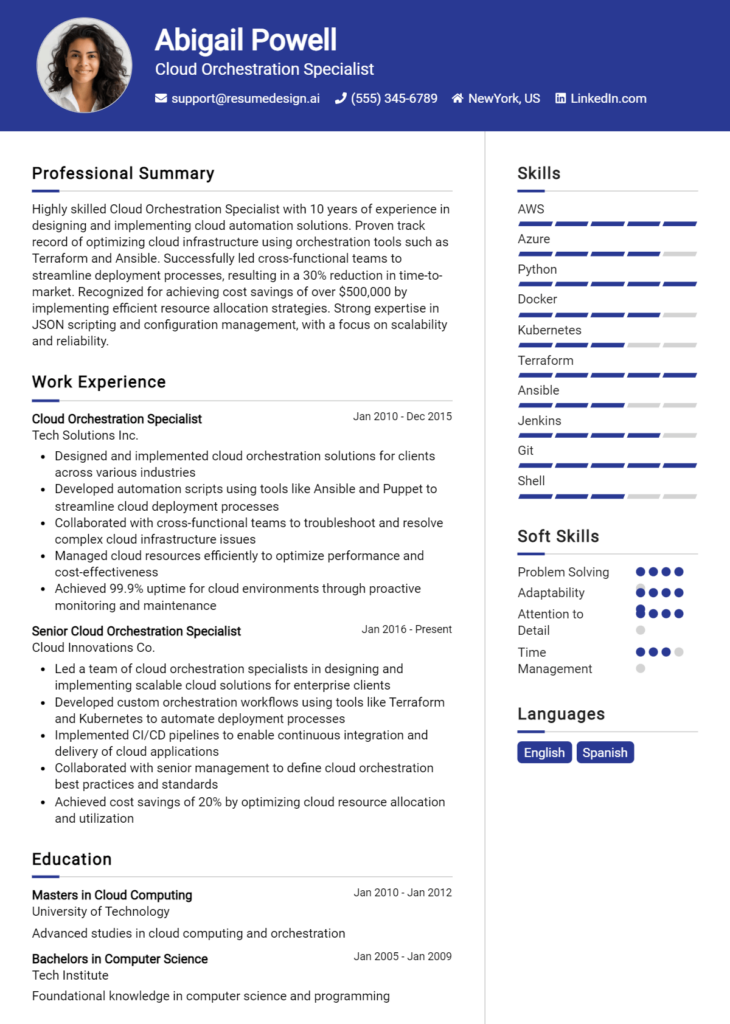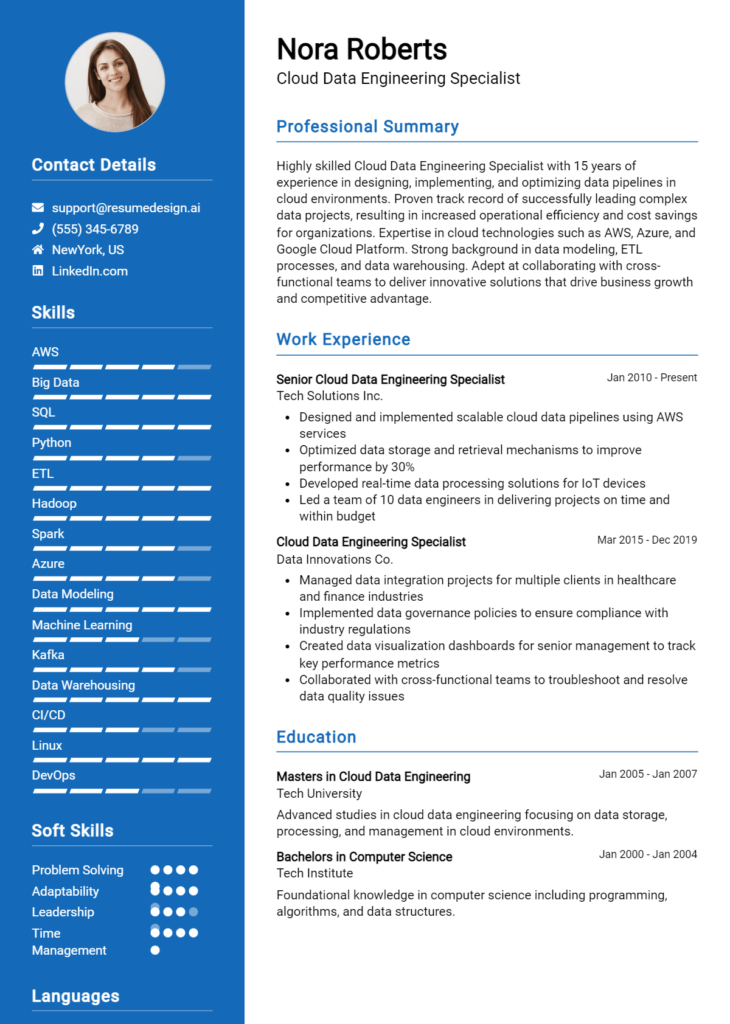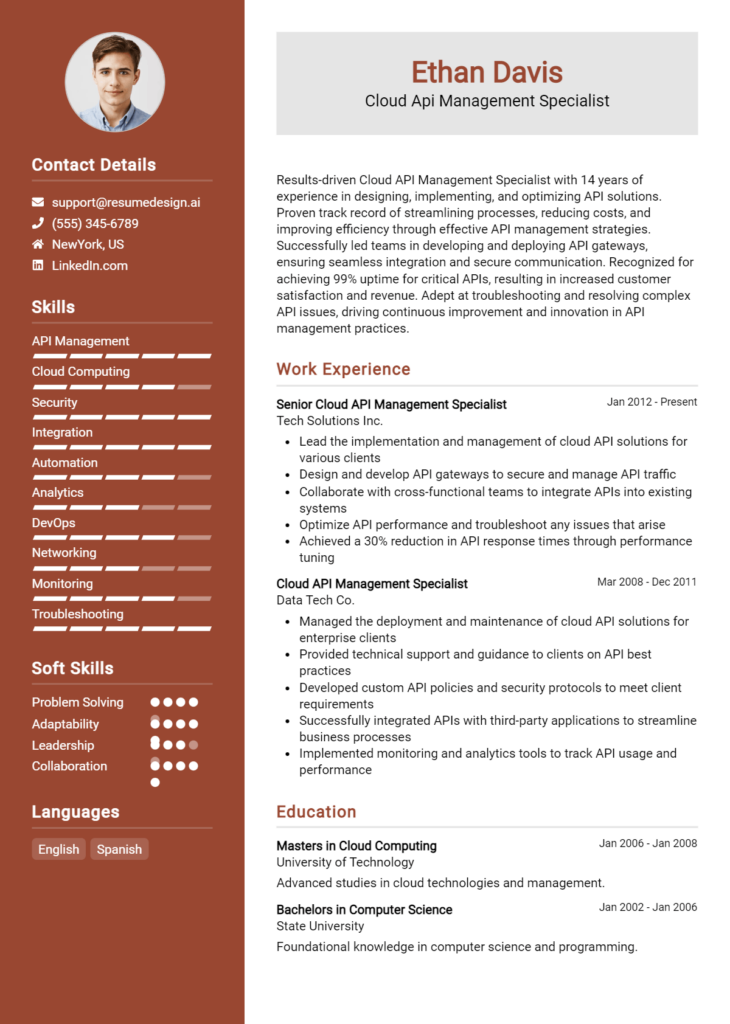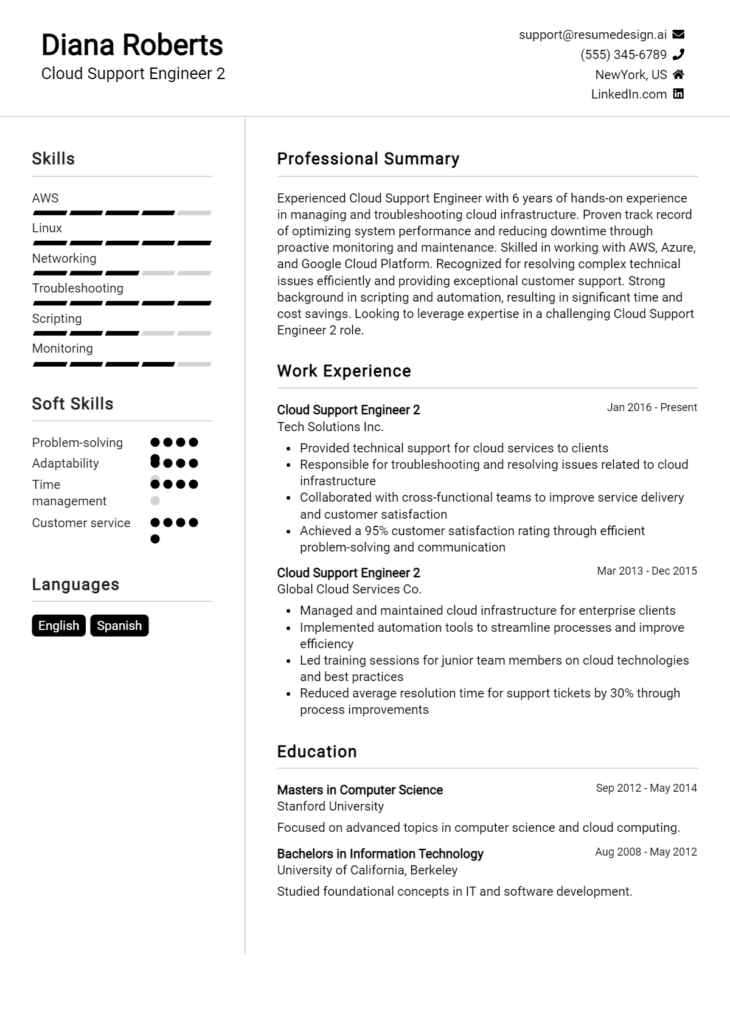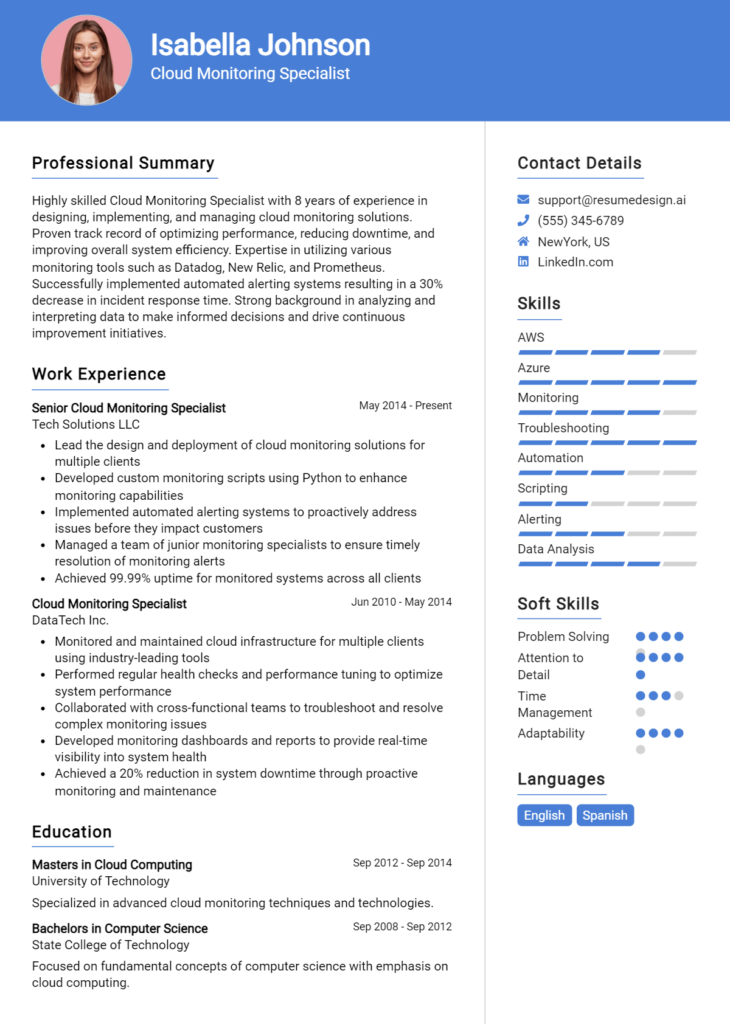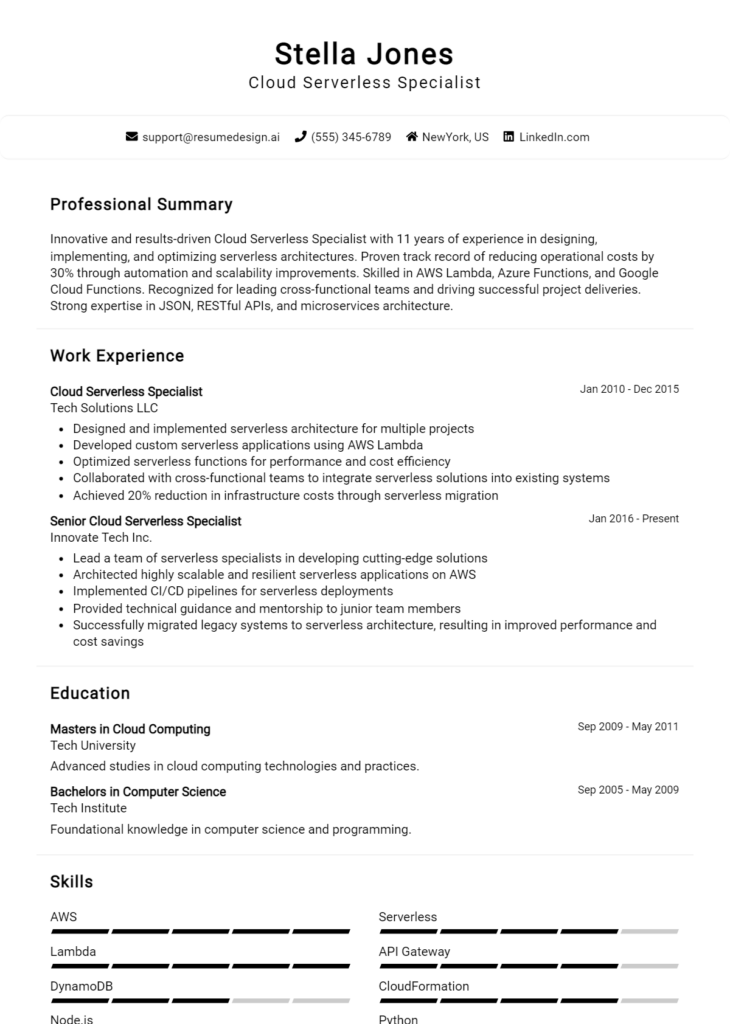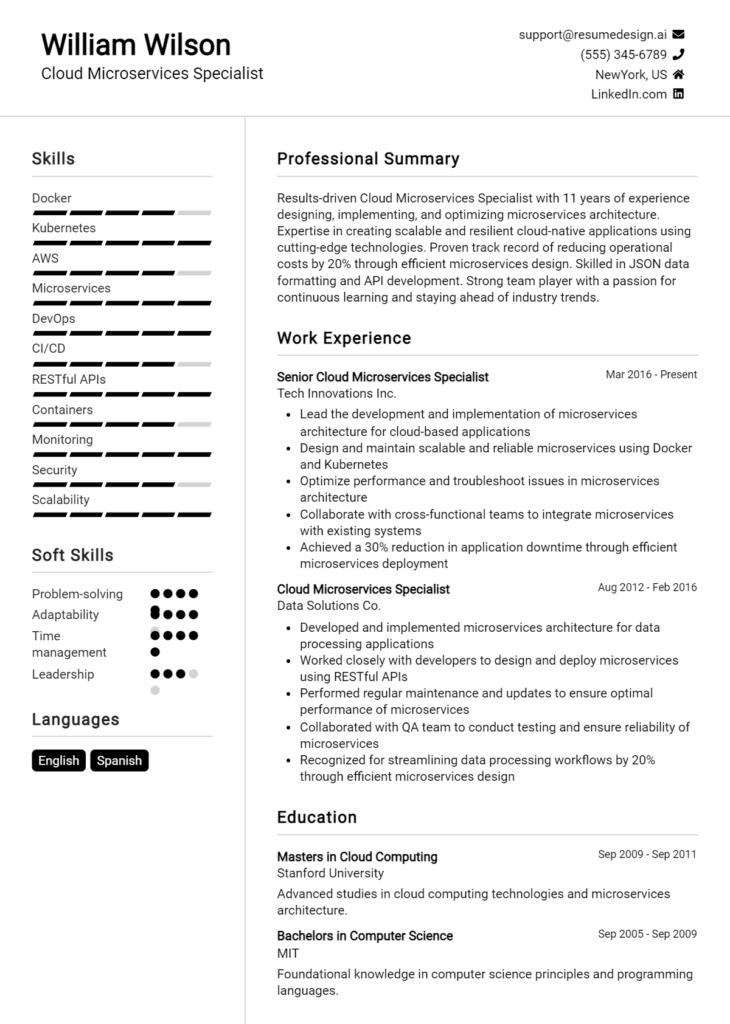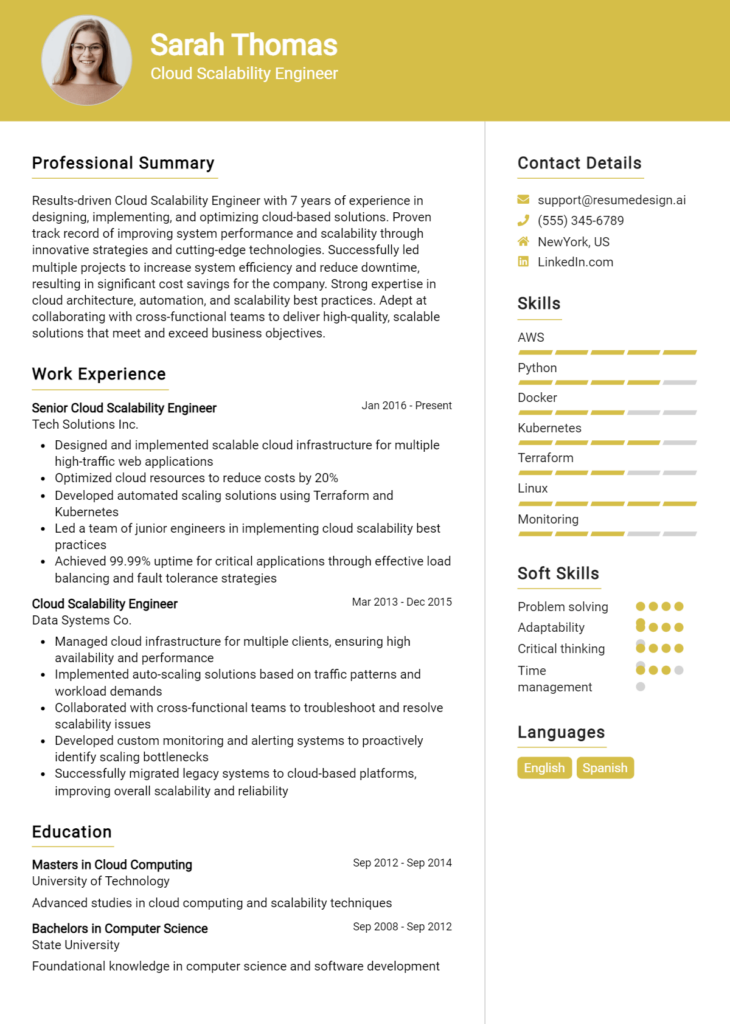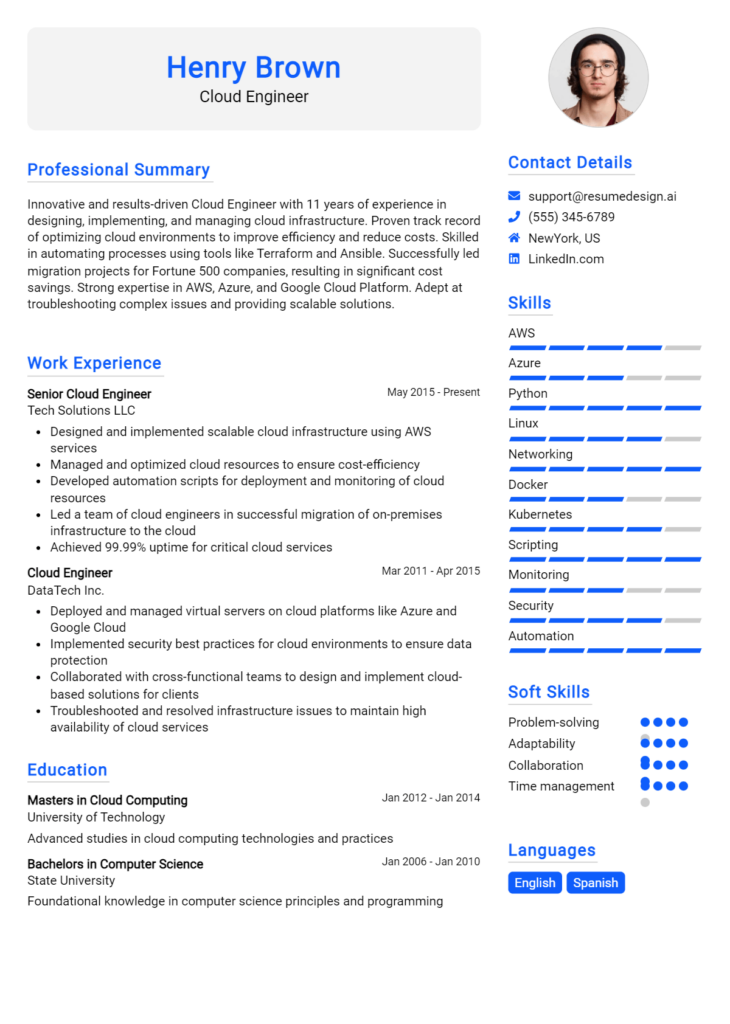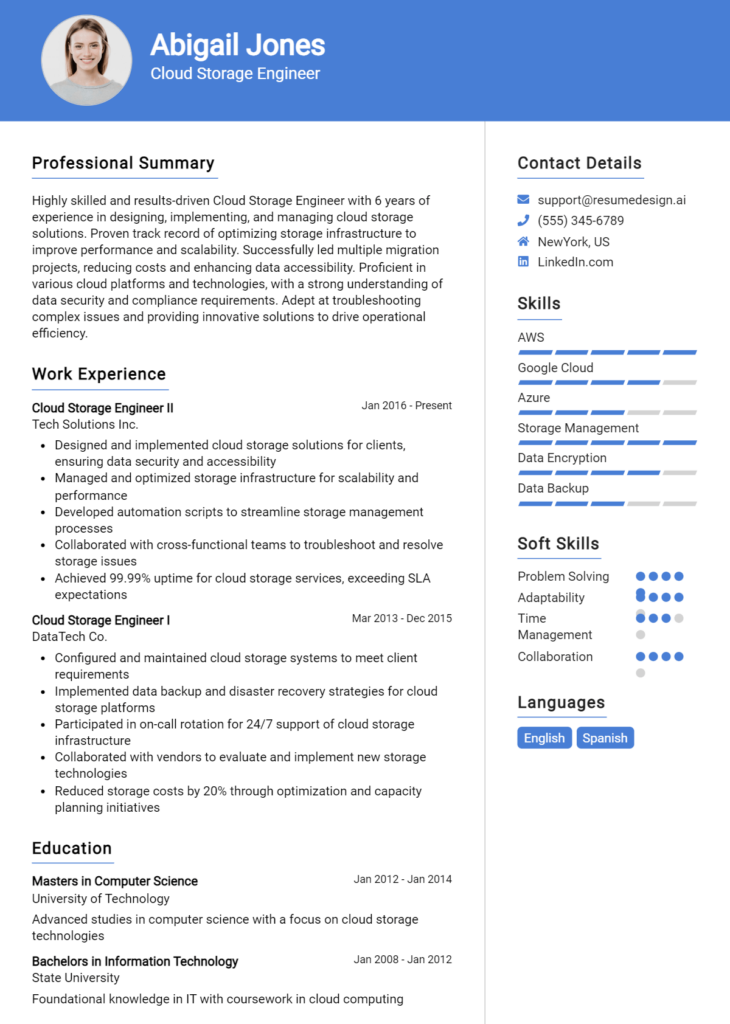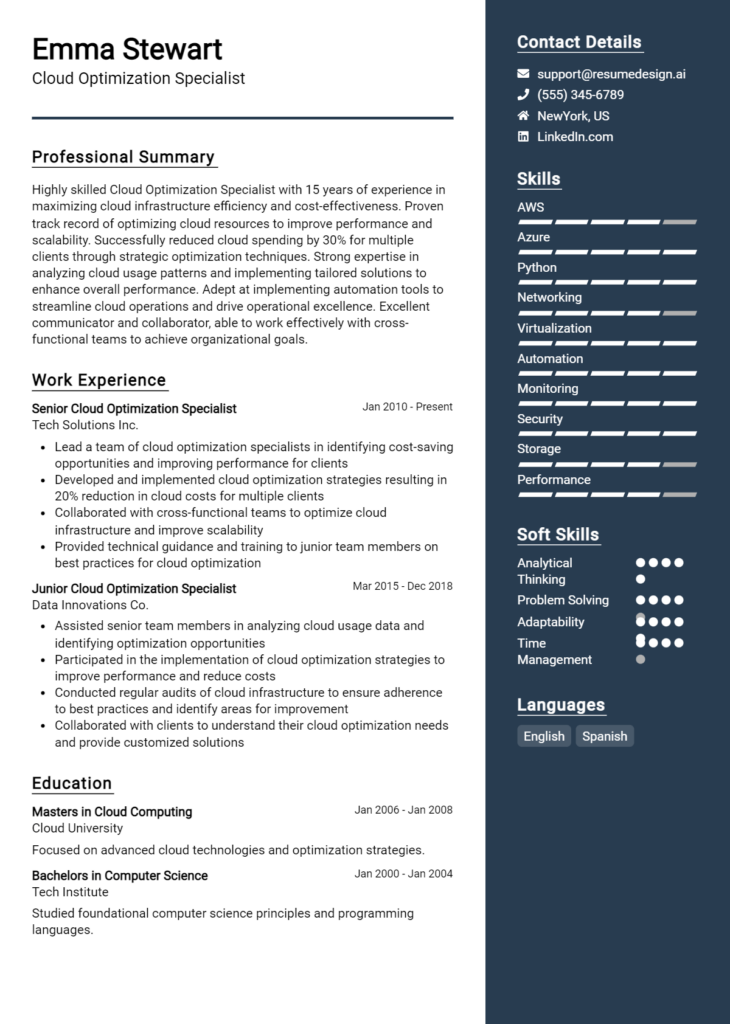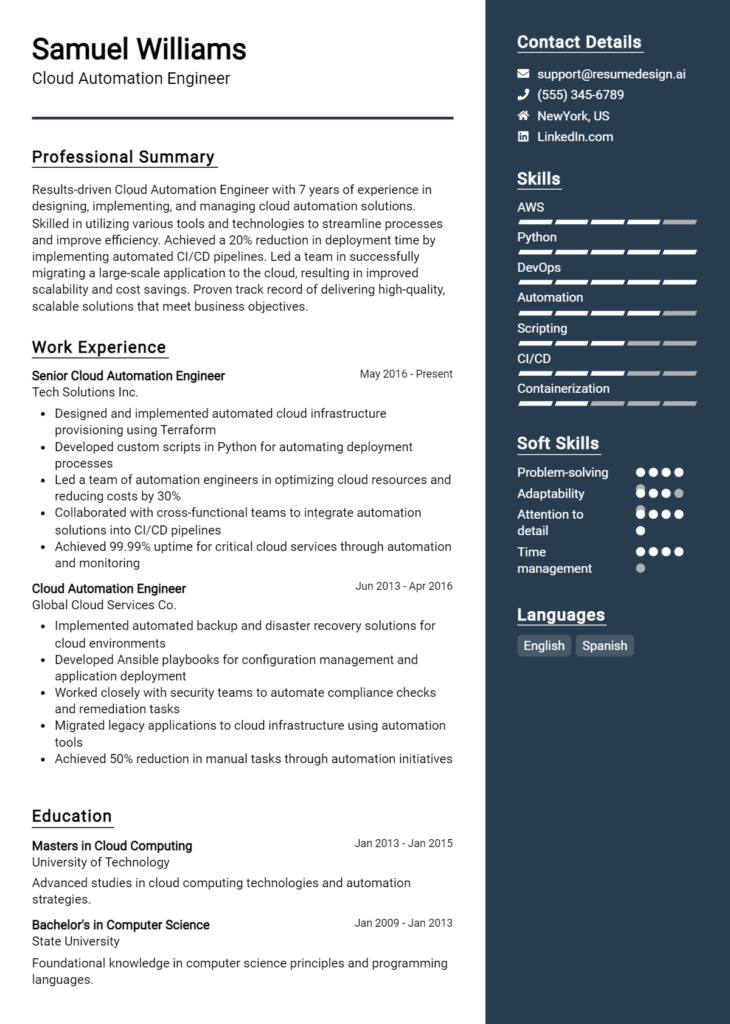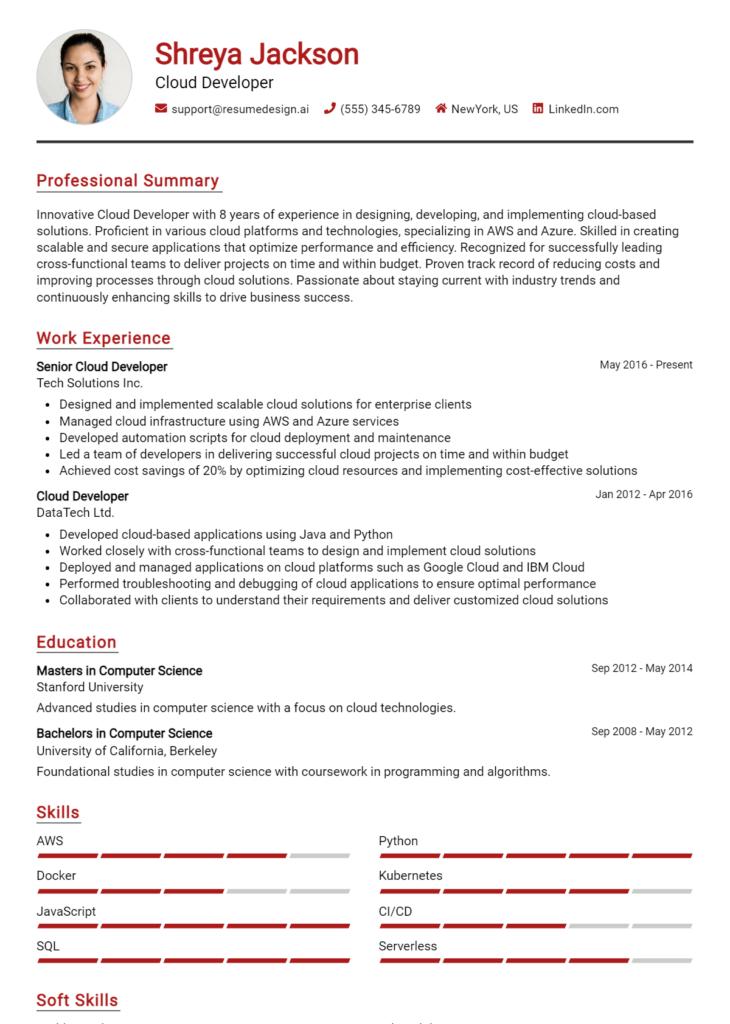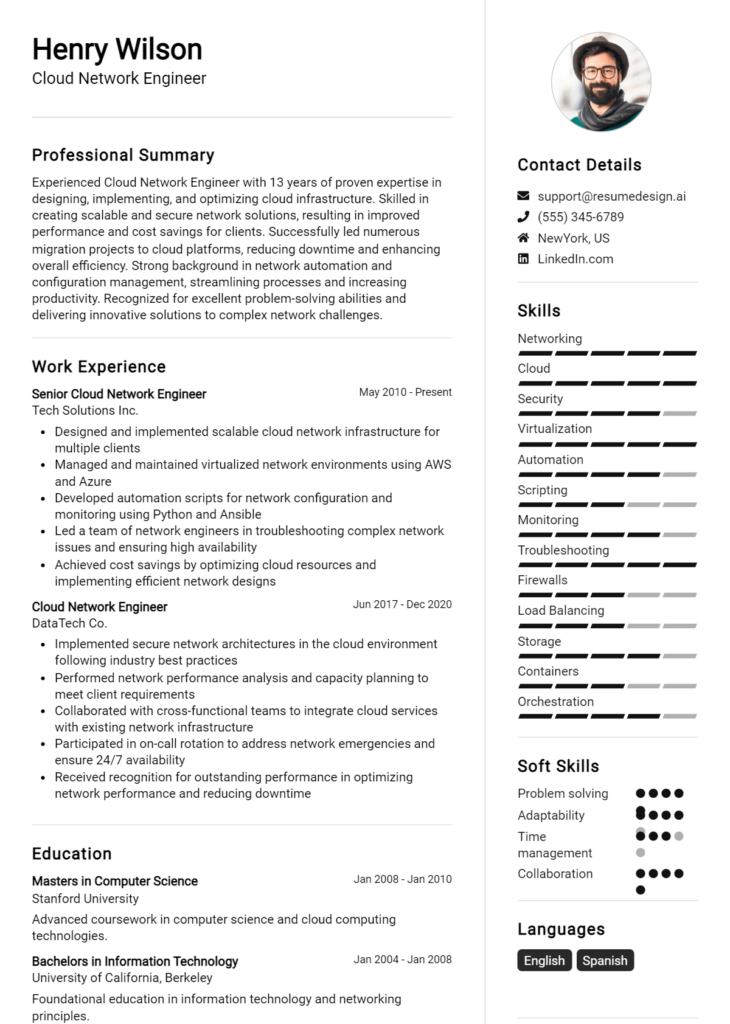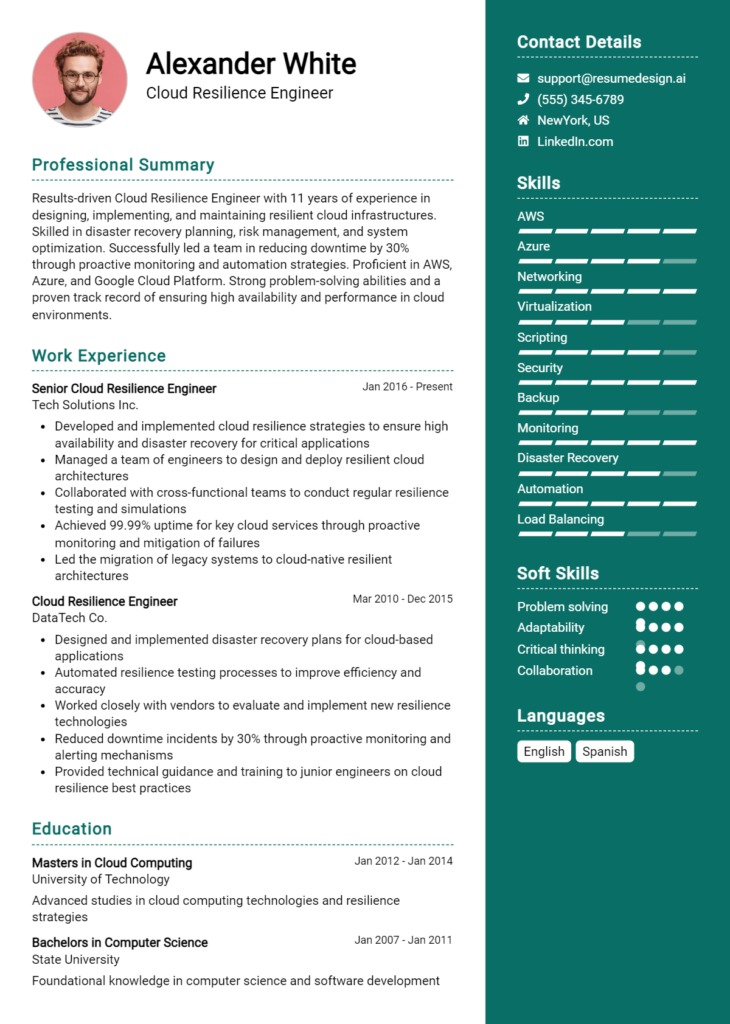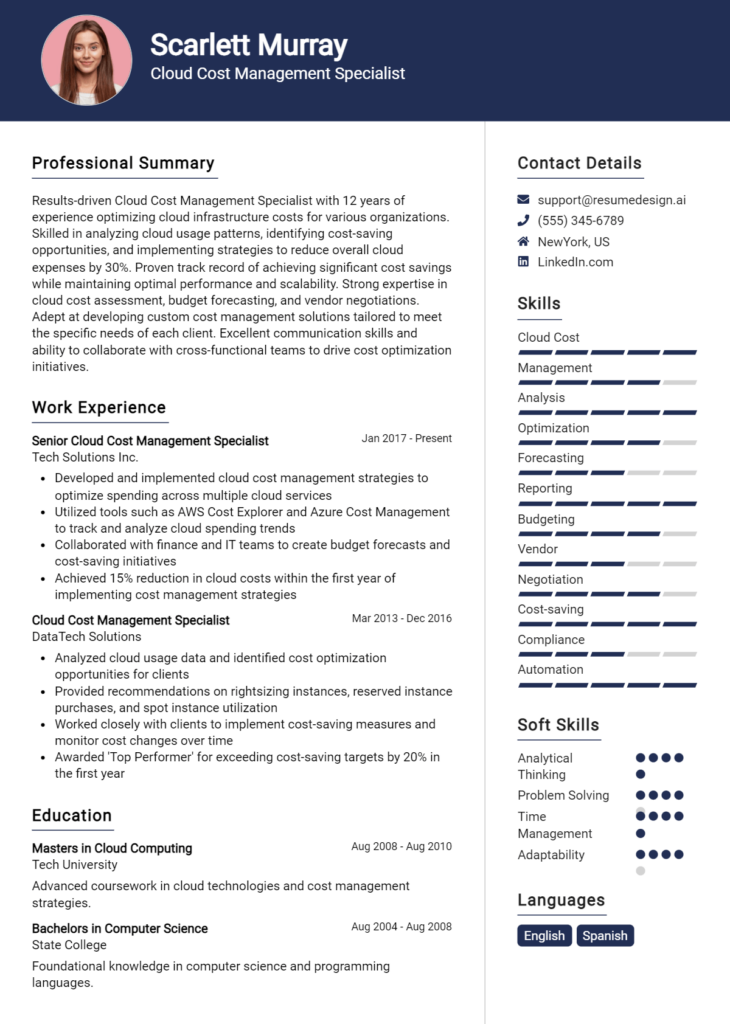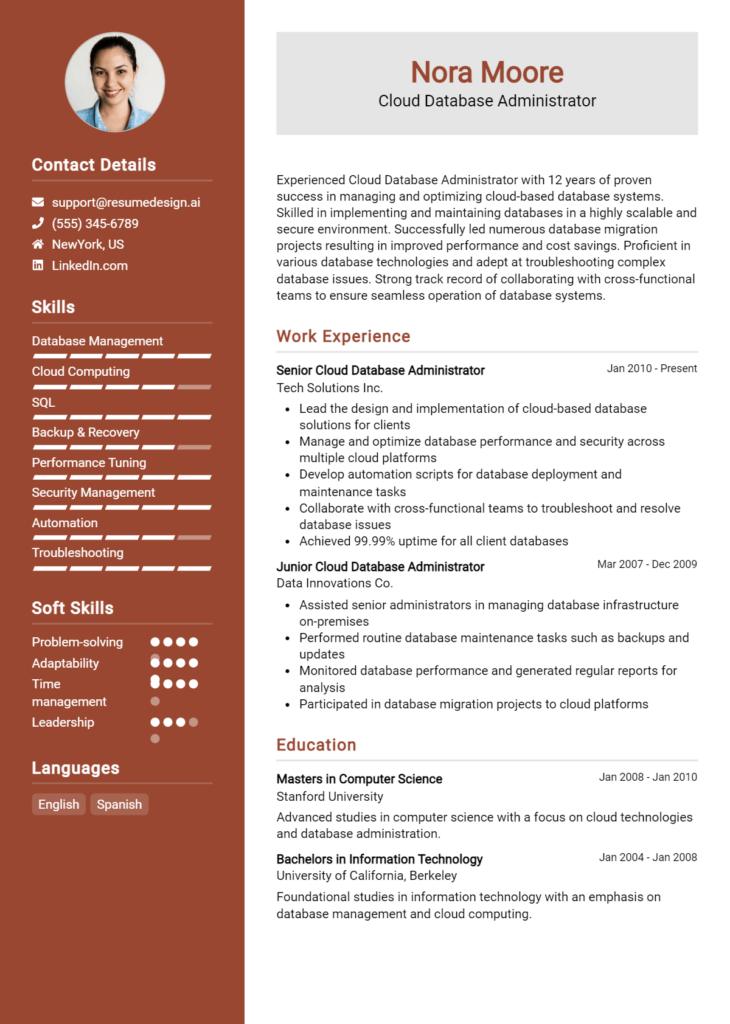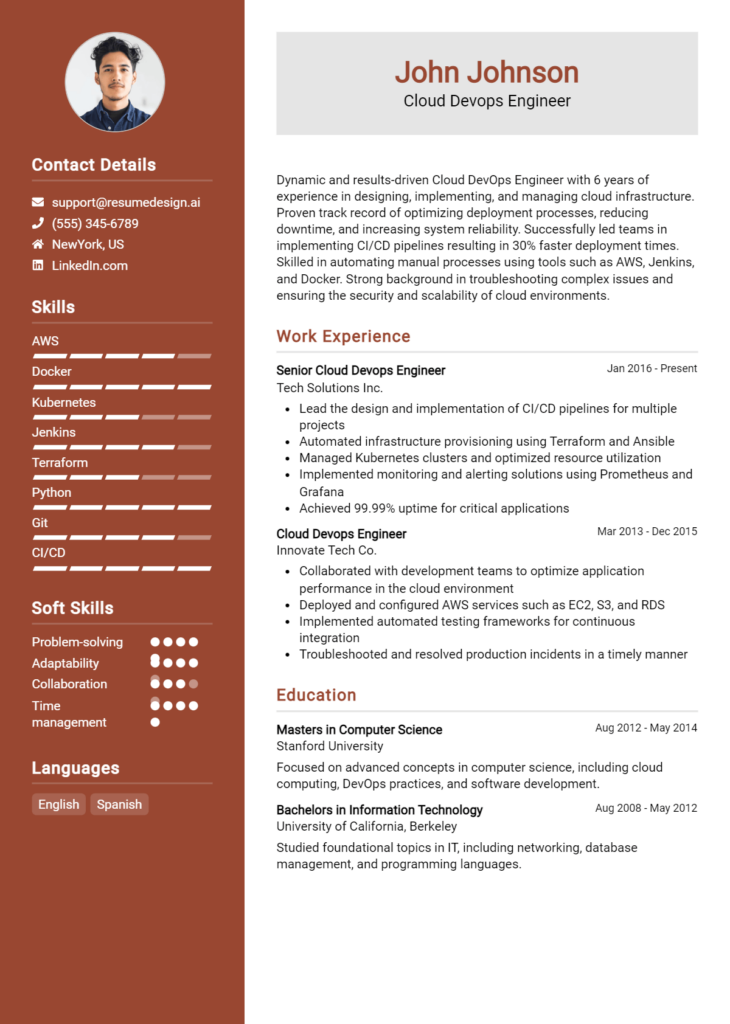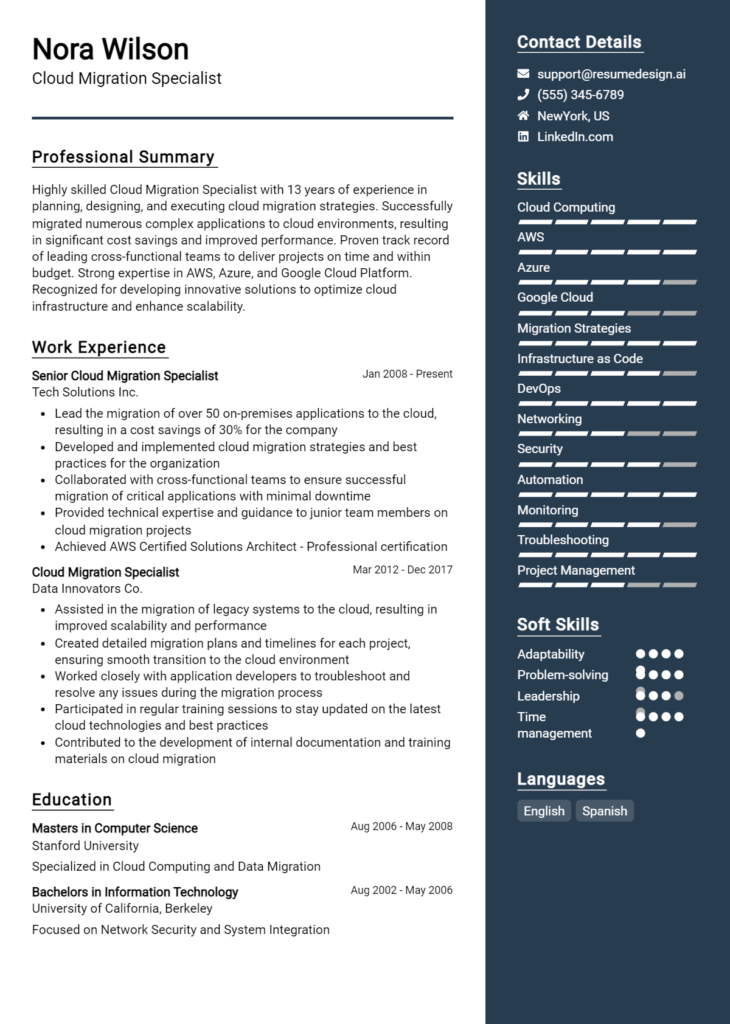Cloud Architect Core Responsibilities
A Cloud Architect plays a pivotal role in designing, implementing, and managing cloud computing strategies that align with an organization’s goals. This professional bridges IT, operations, and development teams, ensuring seamless collaboration. Key responsibilities include assessing cloud needs, architecting solutions, and optimizing cloud performance. Essential skills encompass technical expertise in cloud platforms, strong problem-solving capabilities, and operational knowledge. A well-structured resume showcasing these qualifications can significantly enhance career prospects and demonstrate the value brought to the organization.
Common Responsibilities Listed on Cloud Architect Resume
- Design and implement cloud infrastructure solutions.
- Evaluate and select appropriate cloud services and technologies.
- Develop cloud migration strategies for existing applications.
- Monitor cloud performance and optimize resources.
- Collaborate with cross-functional teams to align cloud strategy.
- Ensure cloud security and compliance with industry standards.
- Provide technical guidance and support for cloud initiatives.
- Document architecture designs and operational procedures.
- Conduct cost analysis and budget management for cloud projects.
- Stay updated on emerging cloud technologies and trends.
- Facilitate training and knowledge transfer to team members.
- Implement disaster recovery and business continuity plans.
High-Level Resume Tips for Cloud Architect Professionals
In the competitive landscape of technology careers, a well-crafted resume is essential for Cloud Architect professionals who aim to make a lasting impression on potential employers. As the first point of contact between candidates and hiring managers, your resume must effectively showcase your skills, experience, and achievements in cloud architecture. It serves not only as a summary of your professional journey but also as a marketing tool that highlights your unique value proposition. This guide will provide practical and actionable resume tips specifically tailored for Cloud Architect professionals, ensuring your resume stands out in a crowded job market.
Top Resume Tips for Cloud Architect Professionals
- Tailor your resume to each job description by incorporating keywords and phrases from the listing.
- Showcase relevant experience by detailing projects that demonstrate your expertise in cloud technologies.
- Quantify your achievements, such as cost savings, performance improvements, or successful implementations.
- Highlight industry-specific skills, including knowledge of cloud service providers like AWS, Azure, and Google Cloud.
- Include certifications relevant to cloud architecture, such as AWS Certified Solutions Architect or Google Cloud Professional Architect.
- Utilize a clean and professional format that enhances readability and draws attention to key information.
- Incorporate a summary statement that encapsulates your qualifications and career goals in cloud architecture.
- Show your soft skills, such as teamwork and communication, which are crucial in collaborative cloud projects.
- List any contributions to open-source projects or community involvement that demonstrate your passion for cloud technologies.
By implementing these tips, you can significantly enhance your resume and increase your chances of landing a job in the Cloud Architect field. A focused and polished presentation of your skills and achievements will not only capture the attention of hiring managers but also position you as a strong candidate ready to tackle the challenges of cloud architecture.
Why Resume Headlines & Titles are Important for Cloud Architect
In the competitive landscape of cloud computing, a Cloud Architect's resume must stand out, and one of the most effective ways to achieve this is through a compelling resume headline or title. A strong headline captures the attention of hiring managers immediately, offering them a succinct summary of a candidate's key qualifications in a single impactful phrase. It serves as a powerful introduction that can set the tone for the entire resume, making it essential to ensure the headline is concise, relevant, and directly aligned with the job being applied for. By effectively showcasing the candidate’s expertise and value proposition, a well-crafted headline can differentiate them from other applicants, making a lasting impression right from the start.
Best Practices for Crafting Resume Headlines for Cloud Architect
- Keep it concise: Aim for a headline that is brief yet informative, ideally no more than 10-12 words.
- Be role-specific: Clearly indicate your role as a Cloud Architect to attract relevant opportunities.
- Highlight key skills: Incorporate essential skills or technologies relevant to the position.
- Showcase accomplishments: If possible, mention a notable achievement that sets you apart.
- Use impactful language: Choose powerful words that convey confidence and expertise.
- Tailor it to the job: Customize your headline for each application to reflect the specific requirements.
- Avoid jargon: Use clear and straightforward language that can be easily understood by all readers.
- Emphasize value proposition: Clearly communicate what you bring to the role and organization.
Example Resume Headlines for Cloud Architect
Strong Resume Headlines
“Certified Cloud Architect with 10+ Years in AWS & Azure Solutions”
“Innovative Cloud Architect Specializing in Scalable Infrastructure Design”
“Results-Driven Cloud Architect with Proven Track Record in Cost Reduction”
“Expert Cloud Architect: Transforming Business Needs into Robust Solutions”
Weak Resume Headlines
“Cloud Architect Looking for Opportunities”
“Experienced IT Professional”
Strong headlines are effective because they communicate specific strengths and relevant experience while immediately indicating the candidate's suitability for the Cloud Architect role. They utilize action-oriented language and emphasize key qualifications, making them memorable to hiring managers. In contrast, weak headlines fail to impress due to their vagueness and lack of specificity; they do not convey any unique value or expertise, which makes it challenging for hiring managers to see why the candidate would be a good fit for the position. A compelling headline can be the difference between a resume being overlooked or making it to the top of the pile for consideration.
Writing an Exceptional Cloud Architect Resume Summary
A well-crafted resume summary is crucial for a Cloud Architect, as it serves as the first impression that catches the attention of hiring managers in a competitive job market. A strong summary succinctly highlights key skills, relevant experience, and notable accomplishments that align with the specific requirements of the role. By capturing the essence of the candidate's qualifications in a concise and impactful manner, it sets the stage for the rest of the resume, increasing the likelihood of progressing to the interview stage. Tailoring the summary to the job description ensures that the candidate stands out as a perfect fit for the position.
Best Practices for Writing a Cloud Architect Resume Summary
- Quantify achievements: Use numbers and metrics to demonstrate the impact of your work.
- Focus on relevant skills: Highlight technical skills and certifications that are directly related to cloud architecture.
- Tailor for the job description: Customize your summary to reflect the specific requirements and keywords from the job posting.
- Highlight key accomplishments: Mention significant projects, successful migrations, or cost savings generated through your cloud solutions.
- Keep it concise: Aim for 3-5 sentences that clearly communicate your value without unnecessary fluff.
- Use action verbs: Start sentences with strong verbs to convey proactivity and leadership.
- Showcase industry knowledge: Include familiarity with various cloud platforms and emerging technologies relevant to the role.
- Maintain a professional tone: Ensure the language is professional and aligns with the expectations of hiring managers in the tech industry.
Example Cloud Architect Resume Summaries
Strong Resume Summaries
Dynamic Cloud Architect with over 8 years of experience in designing scalable, resilient cloud infrastructures. Successfully led a team that migrated over 500 applications to AWS, resulting in a 40% reduction in operational costs.
Innovative Cloud Solutions Architect with a proven track record of delivering high-impact projects. Spearheaded a cloud transformation initiative that increased deployment speed by 60%, enhancing the overall productivity of engineering teams.
Results-driven Cloud Architect with expertise in multi-cloud environments and a strong focus on security compliance. Implemented robust security protocols that reduced vulnerabilities by 30% across all cloud services.
Strategic Cloud Architect skilled in cloud-native application development and DevOps practices. Managed a cross-functional team to successfully deploy a microservices architecture, improving system performance by 50%.
Weak Resume Summaries
Experienced IT professional with a background in cloud technologies.
Cloud Architect with knowledge of different platforms and a desire to improve systems.
The examples of strong resume summaries stand out because they provide specific, quantifiable achievements and demonstrate a clear relevance to the Cloud Architect role. They effectively showcase the candidate's unique value to potential employers. In contrast, the weak summaries lack detail and specificity, failing to convey the candidate's accomplishments or how they can contribute to the organization, making them less compelling in a competitive job market.
Work Experience Section for Cloud Architect Resume
The work experience section of a Cloud Architect resume is critical as it serves as the cornerstone for demonstrating the candidate's technical abilities, leadership skills, and capacity to deliver high-quality projects. This section not only highlights the specific tools and technologies the candidate is proficient in but also illustrates their experience in managing teams and collaborating effectively with various stakeholders. By quantifying achievements and aligning past roles with industry standards, candidates can significantly enhance their appeal to potential employers, showcasing their readiness to tackle complex cloud challenges.
Best Practices for Cloud Architect Work Experience
- Highlight relevant cloud technologies, platforms, and frameworks used in previous roles.
- Quantify achievements with specific metrics, such as cost savings, performance improvements, or project completion timelines.
- Demonstrate leadership by detailing team management experiences and mentoring roles.
- Showcase collaboration with cross-functional teams, including developers, operations, and business stakeholders.
- Tailor your work experience to align with job descriptions and industry trends.
- Include notable certifications or training relevant to cloud architecture.
- Use action verbs to begin bullet points, emphasizing impact and contributions.
- Keep descriptions concise and focused on outcomes rather than just responsibilities.
Example Work Experiences for Cloud Architect
Strong Experiences
- Led a cloud migration project for a Fortune 500 company, resulting in a 30% reduction in operational costs and improved system uptime by 25%.
- Designed and implemented a multi-cloud strategy that improved application availability and scalability, achieving a 40% increase in user satisfaction scores.
- Managed a team of 10 engineers in deploying a serverless architecture, which decreased deployment time by 50% and reduced infrastructure costs by 20%.
- Collaborated with data science teams to architect a big data solution on AWS, enabling real-time analytics that increased decision-making speed by 35%.
Weak Experiences
- Worked on cloud projects that involved various technologies.
- Participated in team meetings to discuss cloud strategies and solutions.
- Assisted in the deployment of cloud applications.
- Helped with troubleshooting and maintaining cloud services.
The examples classified as strong are characterized by specific achievements, quantifiable results, and clear indications of leadership and collaboration. They demonstrate a direct impact on the organization and provide tangible evidence of the candidate's abilities. In contrast, the weak experiences are vague and lack measurable outcomes, which makes it difficult for employers to assess the candidate's true contributions and skill level. Clear, results-oriented statements are essential for making a compelling impression.
Education and Certifications Section for Cloud Architect Resume
The education and certifications section of a Cloud Architect resume is critical as it serves as a testament to the candidate's academic background, professional qualifications, and commitment to continuous learning in the rapidly evolving field of cloud technology. This section not only showcases relevant degrees and industry-recognized certifications but also highlights any specialized training and coursework that align with the job role. By providing detailed information on educational achievements and certifications, candidates can significantly enhance their credibility and demonstrate their preparedness to tackle the challenges associated with cloud architecture roles.
Best Practices for Cloud Architect Education and Certifications
- Focus on relevant degrees, such as Computer Science, Information Technology, or Cloud Computing.
- Highlight industry-recognized certifications like AWS Certified Solutions Architect, Google Cloud Professional Architect, or Microsoft Azure Solutions Architect Expert.
- Include specialized training programs that showcase your expertise in specific cloud technologies or tools.
- Provide details about relevant coursework that directly applies to cloud architecture, such as cloud security, microservices, or network architecture.
- Ensure that certifications are current and not expired, demonstrating ongoing professional development.
- Consider including any leadership or management training relevant to overseeing cloud projects and teams.
- Be specific about the level of certification, indicating whether it is foundational, associate, or professional level.
- List certifications in a clear format, including the issuing organization and the date obtained to enhance credibility.
Example Education and Certifications for Cloud Architect
Strong Examples
- Bachelor of Science in Computer Science, XYZ University, 2015
- AWS Certified Solutions Architect – Professional, AWS, 2022
- Google Cloud Professional Cloud Architect Certification, Google, 2021
- Coursework in Cloud Computing, Network Security, and Microservices Architecture, XYZ University
Weak Examples
- Associate Degree in Business Administration, ABC College, 2013
- CompTIA A+ Certification, CompTIA, 2018
- Old Cisco Certified Network Associate (CCNA), Cisco, 2016
- Basic Computer Skills Course, Online Learning Platform, 2020
The strong examples are considered relevant and effective because they pertain directly to the skills and knowledge necessary for a Cloud Architect role. They include appropriate degrees and current certifications from reputable organizations, demonstrating a commitment to the field. Conversely, the weak examples reflect outdated or unrelated qualifications that do not align with the demands of a Cloud Architect position, such as degrees in unrelated fields or certifications that do not pertain to cloud technology.
Top Skills & Keywords for Cloud Architect Resume
In today's technology-driven landscape, the role of a Cloud Architect is integral to the success of organizations transitioning to digital solutions. A well-crafted resume that highlights the relevant skills is essential for standing out in a competitive job market. The skills listed not only showcase technical proficiency but also emphasize the ability to collaborate, communicate, and innovate within a team. As companies seek professionals who can design, implement, and manage cloud-based solutions effectively, having a robust set of skills on your resume can significantly enhance your chances of landing the desired role. For more insights on the right skills to include, check out skills.
Top Hard & Soft Skills for Cloud Architect
Soft Skills
- Strong communication skills
- Problem-solving abilities
- Team collaboration
- Critical thinking
- Adaptability
- Leadership qualities
- Time management
- Creativity and innovation
- Conflict resolution
- Customer-focused mindset
Hard Skills
- Cloud service models (IaaS, PaaS, SaaS)
- Familiarity with AWS, Azure, or Google Cloud Platform
- Cloud architecture design principles
- DevOps practices and tools
- Network configuration and management
- Security protocols and compliance
- Database management (SQL, NoSQL)
- Infrastructure as Code (IaC) tools (e.g., Terraform, CloudFormation)
- Monitoring and performance optimization
- Experience with containerization (Docker, Kubernetes)
Highlighting both soft and hard skills on your resume can provide a comprehensive view of your capabilities as a Cloud Architect. A well-rounded skill set not only demonstrates technical expertise but also indicates your ability to thrive in diverse workplace environments. Additionally, showcasing relevant work experience alongside these skills can further strengthen your application.
Stand Out with a Winning Cloud Architect Cover Letter
Dear [Hiring Manager's Name],
I am writing to express my interest in the Cloud Architect position at [Company Name] as advertised on [where you found the job listing]. With a strong background in designing and implementing scalable cloud solutions and a proven record of enhancing business performance through innovative technology strategies, I am excited about the opportunity to contribute to your team. My experience in leading cloud migration projects and optimizing cloud infrastructure aligns perfectly with the goals of your organization.
In my previous role at [Previous Company Name], I successfully led a team in migrating over 200 on-premise applications to a cloud-native environment, resulting in a 30% reduction in operational costs. I utilized my expertise in AWS and Azure to design robust architectures that not only improved system performance but also ensured compliance with industry standards. My collaborative approach allowed me to work closely with cross-functional teams to understand their needs, thus delivering tailored solutions that enhanced productivity. I am particularly drawn to [Company Name] because of its commitment to innovation and its forward-thinking approach to cloud technology.
I am adept at leveraging automation tools and CI/CD pipelines to streamline deployment processes and improve efficiency. My ability to analyze existing systems and identify areas for improvement has led to significant enhancements in system reliability and performance. I am passionate about staying current with cloud trends and technologies, which I believe is crucial for driving strategic initiatives in today's fast-paced digital landscape. I am eager to bring my skills in cloud architecture, project management, and stakeholder engagement to [Company Name] to help achieve its cloud transformation objectives.
Thank you for considering my application. I am looking forward to the opportunity to discuss how my experience and vision for cloud architecture can contribute to the continued success of [Company Name]. I am enthusiastic about the prospect of joining such a dynamic team and am excited to potentially bring my expertise to your organization.
Sincerely,
[Your Name]
[Your LinkedIn Profile]
[Your Contact Information]
Common Mistakes to Avoid in a Cloud Architect Resume
When crafting a resume for a Cloud Architect position, it's essential to present your skills and experience in a way that aligns with the expectations of employers in the tech industry. Unfortunately, many candidates make common mistakes that can undermine their qualifications and reduce their chances of landing an interview. By avoiding these pitfalls, you can create a compelling and effective resume that highlights your expertise in cloud technologies and architecture.
Lack of Specificity: Failing to provide specific details about your experience with cloud platforms (e.g., AWS, Azure, Google Cloud) can make your resume seem generic. Employers want to see your hands-on experience and the specific services you've worked with.
Ignoring Certifications: Not highlighting relevant cloud certifications can be a missed opportunity. Certifications demonstrate your commitment to the field and validate your skills, so be sure to include them prominently.
Overloading with Technical Jargon: While it's important to showcase your technical expertise, using too much jargon without explanation can confuse readers. Aim for a balance that demonstrates your knowledge while remaining accessible.
Neglecting Soft Skills: Cloud Architects need more than technical skills; they also require strong communication and collaboration abilities. Failing to mention these soft skills can lead employers to question your suitability for team-based projects.
Inconsistent Formatting: A cluttered or inconsistent resume layout can detract from the professionalism of your application. Use a clean, organized format with clear headings and bullet points to improve readability.
No Quantifiable Achievements: Listing responsibilities without quantifying your achievements (e.g., reduced costs by 30%, improved system uptime to 99.9%) makes it difficult for employers to assess your impact. Use metrics to demonstrate your contributions effectively.
Failure to Tailor the Resume: Sending out a one-size-fits-all resume can hurt your chances. Tailor your resume to each job description, aligning your experience and skills with the specific requirements of the role.
Neglecting Continuous Learning: The cloud landscape is constantly evolving. Failing to mention ongoing education, such as courses, workshops, or conferences, can suggest that you are not keeping up with industry trends and advancements.
Conclusion
In conclusion, the role of a Cloud Architect is critical in shaping an organization's cloud strategy and ensuring seamless integration of cloud solutions. The key responsibilities include designing cloud infrastructure, ensuring security and compliance, managing cloud services, and optimizing performance. With the rapid evolution of cloud technologies, staying updated with the latest trends and best practices is essential for success in this role.
As you embark on your journey to becoming a top-tier Cloud Architect or if you're looking to advance your career, it's crucial to present a compelling resume that highlights your skills and experience effectively. We encourage you to take a moment to review your Cloud Architect resume to ensure it aligns with industry standards and showcases your unique qualifications.
To assist you in this process, there are several valuable resources available: explore resume templates for a polished format, try out the resume builder for easy customization, check out resume examples for inspiration, and don’t forget to create an impactful introduction with our cover letter templates. Take the next step in your career—revamp your resume today!

